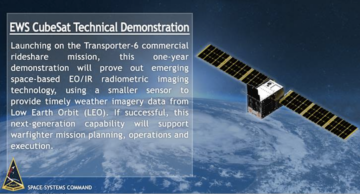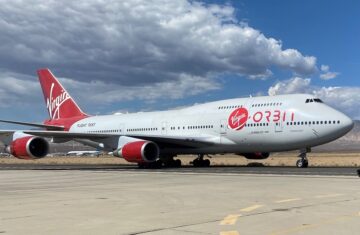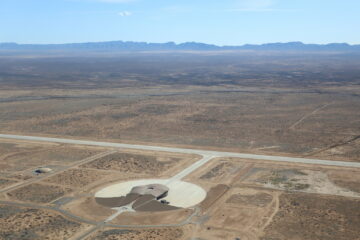
WASHINGTON — Spanish defense contractor Indra has teamed up with local air navigation services provider Enaire to order two satellites next year to test their proposed air traffic surveillance and communications constellation.
Their joint venture, Startical, said March 18 it has ordered a 20-kilogram satellite from GomSpace and a 110-kilogram satellite from Kongsberg NanoAvionics — the first of more than 270 spacecraft planned for low Earth orbit.
Startical said the GomSpace satellite would be deployed in early 2025, followed by NanoAvionics around the middle of the year, but did not disclose launch details.
The company plans to test the performance of a receiver for tracking Automatic Dependent Surveillance-Broadcast (ADS-B) signals from aircraft and a very high-frequency (VHF) radio system for improving pilot communications.
Financial and technical details were not disclosed.
“Our goal is to become the main global provider of air traffic management technology in the space segment and a market leader in satellite surveillance and voice and data communications services,” Startical CEO J. Enrique González Laguna said in a statement.
Satellite operator Viasat seeks to improve airspace-tracking capabilities with its L-band satellites to complement currently congested VHF data links, as part of an air traffic modernization program with the European Space Agency.
According to ESA, fitting aircraft with higher-bandwidth communications would give air traffic controllers more data to schedule landings in advance, minimizing fuel consumption and maximizing airspace and airport capacity.
Viasat says communications between pilots and controllers using the Iris network could also move from voice to text messages for improved operational safety and efficiency.
Europe’s easyJet recently became the airline to use Iris commercially, Viasat announced Jan 29.
“Iris provides everything the industry needs to modernise Air Traffic Management today and is fully operational,” a Viasat spokesperson said via email.
The service is currently deployed in Europe through a group of 19 air navigation service providers, Viasat added, with more expected to join in the coming months.
Startical said its proposed VHF constellation would use the aeronautical radio communications band approved in December by the International Telecommunication Union (ITU), part of the United Nations.
U.S.-based Aireon, which currently provides ADS-B surveillance services using hosted payloads on Iridium Communications’ low Earth orbit constellation, also announced plans March 7 to get a license for operating a space-based VHF system in the newly allocated spectrum band.
Space-based VHF holds particular promise for areas with limited connectivity or without ground infrastructure, Aireon said, such as remote regions and oceanic routes.
Like space-based ADS-B, Aireon said space-based VHF could help improve airspace safety, efficiency, and sustainability by reducing the distance between aircraft and more efficient routing.
“Space-based VHF has tremendous potential for the entire aviation industry,” Aireon CEO Don Thoma told SpaceNews via email, “and it will require investment of the entire industry to be successful. We are looking forward to seeing the results of Starticle’s first satellite launches.”
Thoma said Aireon has spent more than 10 years developing, deploying, and operating what is currently the only global space-based ADS-B system.
The company is looking to draw on this experience for its venture into space-based VHF, along with partners that include Iridium and air navigation services providers based in the United Kingdom, Canada, Ireland, Italy, and Denmark.
- SEO Powered Content & PR Distribution. Get Amplified Today.
- PlatoData.Network Vertical Generative Ai. Empower Yourself. Access Here.
- PlatoAiStream. Web3 Intelligence. Knowledge Amplified. Access Here.
- PlatoESG. Carbon, CleanTech, Energy, Environment, Solar, Waste Management. Access Here.
- PlatoHealth. Biotech and Clinical Trials Intelligence. Access Here.
- Source: https://spacenews.com/startical-orders-test-satellites-for-air-traffic-surveillance-and-comms-constellation/
- :has
- :is
- :not
- $UP
- 10
- 19
- 2025
- 7
- a
- added
- advance
- agency
- AIR
- aircraft
- airline
- airport
- airspace
- allocated
- along
- also
- an
- and
- announced
- approved
- ARE
- areas
- around
- AS
- Automatic
- aviation
- BAND
- based
- BE
- became
- become
- between
- but
- by
- Canada
- Capacity
- ceo
- coming
- commercially
- Communications
- communications services
- company
- Complement
- Connectivity
- consumption
- Contractor
- could
- Currently
- data
- December
- Defense
- Denmark
- dependent
- deployed
- deploying
- details
- developing
- DID
- Disclose
- distance
- don
- draw
- Early
- earth
- efficiency
- efficient
- Entire
- ESA
- Europe
- European
- European Space Agency
- everything
- expected
- experience
- First
- fitting
- followed
- For
- Forward
- from
- Fuel
- fully
- get
- Give
- Global
- goal
- Ground
- Group
- help
- High-Frequency
- holds
- hosted
- HTTPS
- improve
- improved
- improving
- in
- include
- industry
- Infrastructure
- International
- International Telecommunication Union
- into
- investment
- ireland
- iris
- IT
- Italy
- ITS
- Jan
- join
- joint
- joint venture
- jpg
- Kingdom
- laguna
- landings
- launch
- launches
- leader
- License
- Limited
- links
- local
- looking
- Low
- Main
- management
- March
- Market
- Market Leader
- maximizing
- messages
- Middle
- minimizing
- modernization
- months
- more
- more efficient
- move
- Nations
- Navigation
- needs
- network
- newly
- next
- of
- on
- only
- operating
- operational
- operator
- or
- Orbit
- order
- orders
- part
- particular
- partners
- performance
- pilot
- Pilots
- planned
- plans
- plato
- Plato Data Intelligence
- PlatoData
- potential
- Program
- promise
- proposed
- provider
- providers
- provides
- Radio
- recently
- reducing
- regions
- remote
- require
- Results
- routes
- routing
- s
- Safety
- Said
- satellite
- satellites
- says
- schedule
- seeing
- segment
- service
- service providers
- Services
- signals
- Space
- space-based
- spacecraft
- Spanish
- Spectrum
- spent
- spokesperson
- Statement
- successful
- such
- surveillance
- Sustainability
- system
- teamed
- Technical
- Technology
- telecommunication
- test
- text
- than
- that
- The
- the United Kingdom
- their
- this
- Through
- to
- today
- Tracking
- traffic
- tremendous
- two
- union
- United
- United Kingdom
- united nations
- use
- using
- venture
- very
- via
- Voice
- we
- were
- What
- What is
- which
- will
- with
- without
- would
- would give
- year
- years
- zephyrnet







